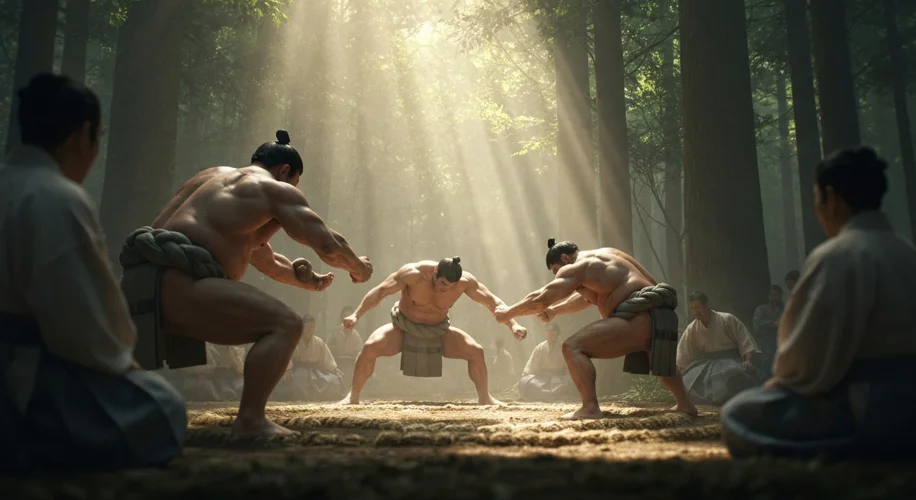The air in the Tokyo arena crackles with an energy both ancient and raw. Two colossal figures, clad in nothing but their mawashi (loincloths), face each other across a perfectly circular clay ring – the dohyo. They bow, a gesture of respect that belies the explosive force about to be unleashed. This is sumo, Japan’s national sport, a ritualized combat steeped in centuries of tradition and spirituality.
But sumo is no longer confined to the hallowed grounds of Japan. In recent decades, the world has witnessed a fascinating phenomenon: the internationalization of sumo, with athletes from diverse backgrounds not only participating but often dominating this unique martial art.
Echoes of the Gods: Sumo’s Sacred Origins
To understand sumo is to delve into the very soul of ancient Japan. Its origins are shrouded in myth and legend, with many believing it was first performed as a ritual to appease the gods, ensuring bountiful harvests. Shinto priests would engage in wrestling matches, a solemn and sacred act that connected the earthly realm with the divine.

Over the centuries, these ritualistic beginnings evolved. During the Edo period (1603-1868), sumo transformed into a professional sport, with organized tournaments and formalized rules. Wrestlers, known as rikishi, were revered figures, their lives dedicated to rigorous training and the pursuit of honor. Their training camps, or heya, became insular communities where tradition, discipline, and loyalty were paramount.
The Rigors of the Dohyo: A Day in the Life of a Rikishi
The life of a sumo wrestler is one of extreme dedication and sacrifice. Waking before dawn, they train for hours, honing their bodies into powerful engines of explosive strength and incredible balance. Their diet is carefully managed, consisting of hearty chankonabe (a protein-rich stew) to help them gain and maintain their formidable size. The dohyo is their stage, their battlefield, and their temple. Each bout, though often lasting mere seconds, is the culmination of years of intense preparation.
Key to sumo’s philosophy are the concepts of jita-kyoei (mutual welfare and benefit) and seiryoku-zenyo (maximum efficiency, minimum effort). While seemingly paradoxical in a sport of brute force, these principles guide the rikishi’s approach: to cooperate within their stable and to utilize their opponent’s strength against them, achieving victory with grace and minimal wasted energy.
The West Invades the Dohyo: A Tale of Foreign Champions
For centuries, sumo remained an almost exclusively Japanese affair. The insular nature of the heya system, the unique cultural context, and the sheer difficulty of mastering the sport acted as formidable barriers. However, the late 20th century saw a seismic shift. The doors of the dohyo began to open, and foreign-born wrestlers started to make their mark.
The first true foreign superstar was Konishiki Yasokichi, a native of Hawaii who burst onto the scene in the late 1980s. His immense size and powerful style captivated audiences, and his success paved the way for others. But it was the arrival of Akebono Taro, another Hawaiian, who truly broke the mold. In 1993, Akebono achieved the coveted yokozuna (grand champion) rank, the pinnacle of sumo, a feat previously thought impossible for a non-Japanese.

Following Akebono, a wave of foreign talent, particularly from Mongolia, began to dominate the top ranks. Wrestlers like Asashōryū Akinori, Hakuhō Shō, and Harumafuji Kōhei became household names, their winning streaks etching their names into sumo history. These athletes, while excelling in a Japanese sport, brought their own cultural backgrounds and fighting spirits, adding new dimensions to the ancient art.
Cultural Currents and Lingering Tensions
The internationalization of sumo hasn’t been without its complexities. While many embrace the global talent for elevating the sport, there have been instances of cultural clashes and anxieties. Debates have arisen regarding foreign wrestlers’ commitment to sumo’s traditions, their perceived lack of respect for the established hierarchy, and the emotional expression of victory, which can sometimes differ from Japanese norms.
There have also been scandals that have touched upon these cultural divides. Incidents involving foreign wrestlers, or those related to the management of stables with a high proportion of foreign athletes, have sometimes fueled xenophobic sentiments or concerns about the erosion of sumo’s

